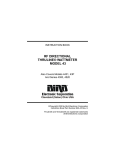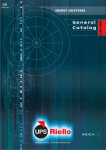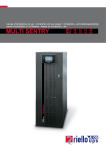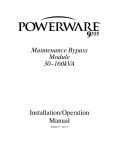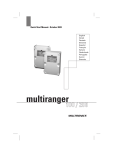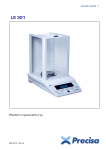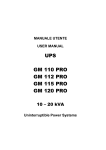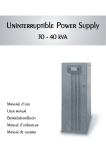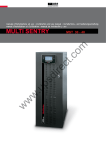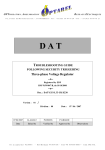Download USER'S MANUAL
Transcript
ETM6k5-10kVA PowerElite MultiTec UPS Installation and Operation Manual MAN451 OPERATING MANUAL We thank you for having chosen our product The manufacturer specializes in the development and production of Uninterruptible Power Supply (UPS). These UPS system are high quality products, carefully designed to meet the highest performance standards. These UPS systems have been designed according to ON LINE - DOUBLE CONVERSION SINE VAWE technology. This user’s manual contains detailed instructions on UPS operation and care. In order to get the best performance from your UPS, please read and follow carefully the instructions described in the following pages. It is recommended that you keep this manual beside your equipment. © No part of this manual may be reproduced in any way without the approval of the manufacturer. Data and drawings are subject to changes without notice and without obligation on the manufacturer’s. WARNING: This unit is a class A (EN50091-2 UPS - EMC requirement specifications). In a domestic environment it may produce radio interference, users may have to adopt further precautions. 2 MAN451 USER’S MANUAL 1 PRECAUTIONS AND SAFETY REGULATIONS 2 DESCRIPTION OF UPS 2.1 General characteristics of UPS. 2.2 Description of UPS 2.3 Technical data table 2.4 Control/warning light panel 2.4.1 2.4.2 2.4.3 2.4.4 Indicator/warning LEDs Control/consultation keys LCD display Buzzer 2.5 Interface 2.5.1 2.5.2 2.5.3 2.5.4 RS232 Remote controls E.P.O. Expansion slots 3 INSTALLATION 3.1 Installation area requirements 3.2 Preliminary tasks 3.3 View of rear panel 3.4 Connections 3.4.1 3.4.2 3.4.3 3.4.4 Connection of single phase mains and load Connection of tree-phase mains and single-phase load Battery expansion connection Fixing the wheel-lock peg 4 SWITCHING ON THE UPS AND OPERATING MODES 4.1 Procedure for switching on and off 4.1.1 4.1.2 4.1.3 Switching on the UPS with mains power Switching on the UPS with battery power Switching off the UPS 4.2 Operating modes 4.2.1 SMART-ACTIVE 4.3 Maintenance by-pass 4.3.1 4.3.2 Maintenance by-pass remote connection Fuse replacement 5 TROUBLESHOOTING 5.1 Problems and solutions MAN451 1 PRECAUTIONS AND SAFETY REGULATIONS This part of the manual contains precautions that must be strictly observed as they concern SAFETY. a) The UPS MUST NOT BE USED WITHOUT A PROPER EARTH CONNECTION. The first connection to be made must be the earth (ground), to be connected to the terminal marked PE. b) The UPS MUST NOT BE USED WITHOUT A PROPER NEUTRAL CONNECTION. Failure to provide a proper neutral connection could damage the UPS. c) Caution: do not connect the output neutral to the input neutral or earth as doing so could damage the UPS. d) The interior of the UPS is live and DANGEROUS. All installation and maintenance tasks must be carried out by properly qualified personnel ONLY. e) The UPS contains an energy source (i.e. the batteries): The output terminals may therefore be live even when the UPS is not connected to the mains. f) Full battery voltage may cause electric shock. Old batteries are to be treated as TOXIC WASTE and handled accordingly. Never throw batteries into a fire: they could explode. Do not attempt to open the batteries: they are maintenance-free. Bear in mind also that the electrolyte is dangerous for skin and eyes and may be toxic. g) If you notice any liquid seepage or any residual white dust DO NOT switch on the UPS. h) Make sure that water, liquids in general and/or any other foreign objects do not enter the UPS. i) In the event of danger switch off the UPS via the switch at the rear and turn all switches to off. j) If necessary, replace all blown fuses with others of exactly the same type. k) The UPS generates a leakage current of less than 10mA. Warning: the load leakage current should be summed with that of the UPS on the earth protection conductor. l) For battery expansion use only supplied connectors or those authorised by the company. m) The UPS units in this series have been designed for professional use and are unsuitable for domestic use. 4 2 DESCRIPTION OF THE UPS 2.1 General characteristics of the UPS. The UPS units in this series feature the following: • • • • • • • • • • • • • • • • • • • • • • • • Double conversion on-line system By-pass: automatic by-pass utilising bi-directional static switch. Maintenance by-pass without interruption of load feed. Control of input power factor for a sinusoidal absorbed current and in phase with mains voltage (0.99 single-phase input, 0.95 tri-phase input). Hold-up time ≥ 40ms which together with a wide permissible variation for mains voltage (V AC min=170 V AC @ 100% load and V AC min=140 V AC @ 50% load) allows a reduction in the number of times battery power is used. LRCD (Low Ripple Current Discharge) system which gives a low-ripple battery discharge current at 50/100Hz even with highly distorting loads. Microcontroller (16 bit) with on-board flash memory for total control of the UPS. Remote monitoring of UPS via an RS232 interface, a contact port and an expansion slot that allows insertion of the type of interface most suited to your needs (USB, SNMP, modem etc.). Multistandard operating mode that includes three machine operating modes: ON-LINE LINE INTERACTIVE (Stand-by on) SMART ACTIVE Silent, economic running thanks to fan speed control and high efficiency (ON-LINE mode: 91% on battery or single-phase mains, 92% with tree-phase mains; LINE INTERACTIVE or SMART-ACTIVE modes: 98%). Auxiliary redundant power feed that allows operation of by-pass even in the event of main auxiliary power feed failure. Front-rear ventilation to reduce effective overall dimensions by eliminating the need for side clearances. Use of IGBT as switching devices. Self-select of output frequencies. Battery test, automatic or manual. Unlimited expandability via external battery box. LCD display, 2x20, backlight, for easy setting and monitoring of UPS, mains and charge status. Weekly programming function for setting on/off sequences Stand-by function Conformity with standards in force concerning safety and electromagnetic compatibility. MAN451 2.2 Description of the UPS The purpose of a UPS is to guarantee perfect power supply voltage to the connected equipment. Once connected and powered, the UPS generates an alternating sinusoidal voltage of stable amplitude and frequency, independent of any mains surges and/or fluctuations. As long as the UPS draws power from the mains, the batteries are kept charged under the control of a microprocessor. This microprocessor continually monitors mains voltage amplitude and frequency, the amplitude and frequency generated by the inverter, the applied charge, internal temperature and battery efficiency. There follows a block diagram of the UPS (see Fig.1) and a description of its individual parts. Input and output EMI filters Input and output filters for electromagnetic disturbances on the supply. Power Board This manages the power. Rectifier/Boost: these represent the input stage. With mains power on it converts the input AC voltage into two DC voltages (first conversion), one +400 V and the other –400V with respect to the neutral, which power the inverter and the battery charger. Opening and closing of the boost IGBT’s is modulated in such a way as to guarantee sinusoidal current absorption at the input. When working in the absence of mains power it behaves like a DC-DC converter that raises the voltages of the two battery sets to +400V and –400V. The boosts uses a “Step-up” configuration without insulation. Inverter: the inverter transforms continuous boost-supplied voltages into a stabilised sinusoidal alternating voltage (second conversion) used for charging. A half-bridge configuration without insulation with IGBT’s operating at 18KHz is employed. Automatic Static by-pass The automatic by-pass is an scr (static) device which automatically connects the UPS output on the input mains in the event of overload and/or an inverter fault. It is equipped with an auxiliary redundant power supply so that it can be powered in the event of a mains failure. Stand-by Switch Electromechanical device that automatically disconnects UPS inverter output from the charge in the following cases: in stand-by, in by-pass status during on-line mode, in the event of an inverter fault or if the Emergency Power Off (E.P.O.) button is pressed. Battery Charger Made up of two DC-DC converters that draw, under the control of the microprocessor, the continuous +400V and –400V voltages, lowering them to a voltage level suitable for the battery sets to be charged. Batter recharge uses a current of approximately 1 Ampere and lasts from 6 to 8 hours depending on the initial battery charge. The battery charger is deactivated when mains power is cut. 6 Maintenance by-pass By closing the maintenance by-pass (SWMB) switch and then opening the SWIN and SWOUT switches it is possible to carry out maintenance work on the UPS in total safety without having to interrupt the power to the load. The auxiliary contact that informs the microcontroller of switch closure is made available on the input terminal block so as to allow installation of an additional external maintenance by-pass. Control and µC Board These are the boards that control and supervise the UPS Interface Board Contains an RS232 interface as standard, a contact port and the isolated emergency power off (E.P.O.) Interface Slot This is an expansion slot that allows the user to insert an extra interface: a second serial RS232 or a SNMP interface etc. MAN451 8 SWMB Maintenance By-pass Switch Interface slot CONTROL BOARD E.P.O . uC Board Interface Board Remote controls Display Board SWBYP by-pass fuse RS232 POWER BOARD RECTIFIER BOOST Line In SWIN Input breakr IEC 10A max Stand-by Switch Output EMI Filter Line Out SWOUT Output breaker BATTERY CHARGER SWBT + IEC Fuse INVERTER Input EMI Filter SWBT To battery extension Automatic Static By-pass - + Battery - Battery SWBT N SWBT N UPS BLOCK DIAGRAM Neutral 2.3 Technical data tables MODEL INPUT Rated voltage Accepted range Min voltage for non-trip of battery Rated frequency Maximum input current (1) 10000 VA 230 V AC single-phase or tri-phase with neutral 0 – 276 V AC 170 V AC @ 100% load / 140 V AC @ 50% load 50 – 60 Hz + 5 Hz Single phase Tri-phase 50 A 18 A Single phase Tri-phase 37 A 13 A Single phase Tri-phase ≥0.99 ≥0.95 Single phase Single phase < 6% < 27% Rated input current (2) Power factor Distortion current @ distorting load (3) 1.1 BY PASS Voltage range accepted for commutation Frequency range accepted for commutation Inverter/by-pass commutation time 0.1ms 1.2 BATTERY Autonomy in min / W N° batteries / V / Ah Recharge time Rated voltage on autonomy expansion connector 1.3 OUTPUT Rated voltage Static variation (4) Dynamic variation (5) Wave form Voltage distortion @ linear load (3) Distortion voltage @ distorting load (3) Frequency (6) Current peak factor Rated power in VA / W Short circuit current 1.4 VARIOUS 1.5 Leakage current to ground AC/AC efficiency 180 – 264 V AC Selected frequency ±5 Hz 0.1 ms 8’ / 7000 W 15+15 / 12V / 7 Ah (High Current Discharge Capability) 6-8 h ±180 V DC 220 / 230 / 240 V AC selectable + 2% < 1% < 5% in 20 ms (class 1 EN50091-3) Sinusoidal ≤2% ≤5% 50 / 60 Hz, by self-select or selectable 3:1 10000 / 7000 1.5xIn for t=0.5s <10mA Single-phase input 91% DC/AC efficiency Line-interactive efficiency Ambient temperature (7) Humidity Safety devices Tri-phase input 92% 91% 98% 0 - 40 °C < 90 % without condensation excessive battery discharge – overcurrent – short circuit – overvolt – undervolt - overheat EN 50091 – 1 – 1, EEC directive 73/23 and 93/68 EN 50091 - 2 cl. A, EEC directives 89 / 336, 93/68 and 92/31 IEC 801-5 > 40 msec. < 45 dBA at 1 m 735x283x805 135 Conforms to safety requirements EMC conformity Surge capability Hold-up time Noise Dimensions H x L x P (mm) Weight in Kg MAN451 MODEL INPUT Rated voltage Accepted range Min voltage for non-trip of battery Rated frequency Maximum input current (1) Rated input current (2) Power factor Distortion current @ distorting load (3) 1.6 BY PASS Voltage range accepted for commutation Frequency range accepted for commutation Inverter/by-pass commutation time 0.1ms 1.7 BATTERY Autonomy in min / W N° batteries / V / Ah Recharge time Rated voltage on autonomy expansion connector 1.8 OUTPUT Rated voltage Static variation (4) Dynamic variation (5) Wave form Distortion voltage @ linear load (3) Distortion voltage @ distorting load (3) Frequency (6) Current peak factor Rated power in VA / W Short circuit current 1.9 VARIOUS 1.10 Leakage current to ground AC/AC efficiency DC/AC efficiency Line-interactive efficiency Ambient temperature (7) Humidity Safety devices Conforms to safety requirements EMC conformity Surge capability Hold-up time Noise Dimensions H x L x P (mm) Weight in Kg 10 8000 VA 230 V AC single-phase or tri-phase with neutral 0 – 276 V AC 170 V AC @ 100% load / 140 V AC @ 50% load 50 – 60 Hz + 5 Hz Single phase Tri-phase 41 A 15 A Single phase Tri-phase 30 A 11 A Single phase Tri-phase ≥0.99 ≥0.95 Single phase Single phase < 7% < 24% 180 – 264 V AC Selected frequency ±5 Hz 0.1 ms 12’ / 5600 W 15+15 / 12V / 7 Ah (High Current Discharge Capability) 6-8 h ±180 V DC 220 / 230 / 240 V AC selectable ± 2% < 1% < 5% in 20 ms (class 1 EN5091-3) Sinusoidal ≤2% ≤5% 50 / 60 Hz, by self-select or selectable 3:1 8000 / 5600 1.5xIn for t=0.5s <10mA Single-phase input 91% Tri-phase input 92% 91% 98% 0 – 40 °C < 90 % without condensation excessive battery discharge – overcurrent – short circuit – overvolt – undervolt - overheat EN 50091 – 1 – 1, EEC directive 73/23 and 93/68 EN 50091 - 2 cl. A, EEC directives 89 / 336, 93/68 and 92/31 IEC 801-5 > 40 msec. < 45 dBA at 1 m 735x283x805 135 MODELLO INPUT Rated voltage Accepted range Min voltage for non-trip of battery Rated frequency Maximum input current (1) 6500 VA 230 V AC single-phase or tri-phase with neutral 0 – 276 V AC 170 V AC @ 100% load / 140 V AC @ 50% load 50 – 60 Hz + 5 Hz Single phase Tri-phase 31 A 11 A Single phase Tri-phase 22 A 8A Single phase Tri-phase ≥0.99 ≥0.95 Single phase Single phase < 7% < 27% Rated input current (2) Power factor Distortion current @ distorting load (3) 1.11 BY PASS Voltage range accepted for commutation Frequency range accepted for commutation Inverter/by-pass commutation time 0.1ms 1.12 BATTERY Autonomy in min / W N° batteries / V / Ah Recharge time Rated voltage on autonomy expansion connector 1.13 OUTPUT Rated voltage Static variation (4) Dynamic variation (5) Wave form Distortion voltage @ linear load (3) Distortion voltage @ distorting load (3) Frequency (6) Current peak factor Rated power in VA / W Short circuit current 1.14 VARIOUS 1.15 Leakage current to ground AC/AC efficiency 180 – 264 V AC Selected frequency ±5 Hz 0.1 ms 15’ / 4600W 15+15 / 12V / 7 Ah (High Power) 6-8 h ±180 V DC 220 / 230 / 240 V AC selectable ± 2% < 1% < 5% in 20 ms (class 1 EN50091-3) Sinusoidal ≤3% ≤5% 50 / 60 Hz, by self-select or selectable 3:1 6500 / 4600 1.5xIn for t=0.5s <10mA Single-phase input 91% DC/AC efficiency Line-interactive efficiency Ambient temperature (7) Humidity Safety devices Tri-phase input 92% 91% 98% 0 – 40 °C < 90 % without condensation excessive battery discharge – overcurrent – short circuit – overvolt – undervolt - overheat EN 50091 – 1 – 1, EEC directive 73/23 and 93/68 EN 50091 - 2 cl. A, EEC directives 89 / 336, 93/68 and 92/31 IEC 801-5 > 40 msec. < 45 dBA at 1 m 735x283x805 133 Conforms to safety requirements EMC conformity Surge capability Hold-up time Noise Dimensions H x L x P (mm) Weight in Kg (1) @ rated load, rated voltage of 170 V AC, batteries being charged (2) @ rated load, rated voltage of 230 V AC, batteries charged (3) Second appendix M5 of EN50091-1-1 (4) Mains/Battery @ load 0% -100% (5) @ Mains /battery/mains @ resistive load 0%/100%/0% (6) If mains frequency is within +5 Hz of the selected value, the UPS is mains-synchronised. If the frequency is out of tolerance or running off battery, the frequency is that selected +0.1% (7) 20-25°C for longer battery life Warning: To maintain output voltage within the indicated precision range, it may be necessary to recalibrate after a long period of use. MAN451 2.4 Control/warning Indicator panel Current UPS status (see Fig.2) is indicated by: - 6 LEDs - LCD display with two 20-character lines - a buzzer - 5 keys for switching the UPS on and off, interrogating the display and changing UPS settings. 1 2 3 4 6 5 12 11 7 10 8 9 Fig. 2 1) “Mains on” LED 2) “Battery working” LED 3) “Change battery” LED 4) “Load on by-pass” LED 5) “Shutdown / stand-by” LED 6) “Line interactive” LED 12 7) Stand-by key 8) Enter key 9) Scroll key 10) Scroll key 11) ON key 12) LCD display 2.4.1 Indicator/warning LEDs The LEDs provide at-a-glance information as to the current status of the UPS: Mains on (green LED). This is: · on: when the UPS is on and running off the mains. · flashing: after the UPS is switched on until the inverter switches in phase with the mains voltage or when mains frequency is different from output frequency. · flashing alternately: when programmed switching on is activated. Battery working (yellow LED). This LED is: · on: when power is supplied by batteries because there is no mains input or because mains input is incorrect. · flashing: when the batteries have reached the alarm threshold just before their charge is exhausted. Change battery (red LED). This LED is: · on: when the batteries need changing Load on by-pass (green LED). This LED is: · on: when the load is fed by the input mains via the automatic by-pass Shutdown/stand-by (red LED). This LED is: · on: when a UPS warning is activated or when it is shut down (see section 4.1). · flashing: the UPS is in Stand-by mode. Line-interactive (green LED). This LED is: · on: when in line-interactive mode 2.4.2 Control/Interrogation keys ON key This button provides the following functions: • If the UPS is in stand-by, pressing this key for 0.5 seconds switches on the UPS and connects up the output loads. • If batteries are charged and this key is pressed for more than 0.5 seconds, the microprocessor runs a battery efficiency test. If this test shows that the batteries are inefficient the red “Change battery” LED comes on and the buzzer sounds (see section 2.4.4.). • Switches off the buzzer in the following cases (if pressed for at least 0.1 sec): - The UPS switches to battery power (yellow “battery working” LED on). - The UPS, when operating off battery power, reaches the alarm threshold just before charge is exhausted. - The UPS enters the final phase of a programmed shutdown. • Cancels a programmed shutdown if held down for more than 2 seconds during the programmed shutdown wait phase. MAN451 Off key. Switches off the UPS if pressed for at least 1.5 seconds (after 4 beeps). If mains power is present it goes to stand-by. If there is no mains power and the programmed restart function is not activated the UPS shuts down completely. If there is no mains power and the programmed restart function is activated the UPS may be switched off completely by pressing the button for at least 5 seconds. Scroll keys Scroll the information on the display both in display and programming modes. Enter key If the display is in “display” mode pressing for more than 2 seconds switches the UPS to programming mode. In programming mode this key is used to enter/exit the various menus and select options. For more detailed information see the paragraph below. 2.4.3 LCD Display The LCD display gives: at-a-glance info on UPS, input, load and battery status (Display mode) • personalisation via modification of display settings (e.g. language), operating mode (online, line-interactive and smart-active), certain output-relevant parameters (voltage and frequency), configuration (auto-restart, auto-power-off, etc.) • Programming mode: In display mode the display appears as illustrated below: IN=230V 50.0Hz STATUS: STAND-BY The upper line gives information on the mains, output, load, batteries and the heatsink temperature. This information is accessed via the scroll keys. 14 The displayed info is as follows: Input voltage and frequency in single-phase Linked voltages (L1, L2, L3) and input frequency in tri-phase By-pass line voltage and frequency Positive and negative battery branch voltages Autonomy time and percentage of battery charge Output voltage and frequency Apparent power and active power of load Percentage of load with respect to rating and rms current supplied to load Heatsink temperature IN=230V 50.0Hz IN=230 230 230V 50.0 BYP= 230V 50.0Hz BATT= +204V -204V TIME= 8m BATT= 100% OUT= 230V 50.0Hz LOAD= 10.0kVA 7.0kW LOAD= 100% 43A TEMP= 40°C The lower line displays the status of the UPS and shows that the UPS is working correctly on the basis of load, mains and set work mode conditions. Otherwise it gives information on any UPS anomalies, alarms or shutdowns: · Anomalies are low-level problems that do not involve UPS shutdown but only reduce performance or impede utilisation of some of its functions (e.g. the absence of the by-pass fuse does not prevent powering of the load via the inverter but does prevent utilisation of the by-pass line). · The alarms represent problems more serious than anomalies as their persistence can, even in just a short time, cause UPS shutdown. · Shutdowns are usually preceded by an alarm warning and, owing to their seriousness, involve switching off of the inverter and load feed via the by-pass line (except for overload and short-circuit shutdowns). The following page shows the messages that may appear on the lower line of the display. MAN451 OPERATING MODES STATUS: STAND-BY STATUS: INVERTER STATUS : BY-PASS STATUS: BATTERY BATTERY TEST ACTIVE REMOTE BYPAS CONTROL REMOTE OFF CONTROL CHANGE BATTERIES Shows that the UPS is not powering the load but is standing by Shows that the UPS is inverter-powering the load and drawing energy from the mains Shows that the UPS is inverter-powering the load directly from the mains via the automatic by-pass Shows that the UPS is inverter-powering the load and drawing energy from the batteries Shows that the UPS is running a battery test Shows that remote UPS by-pass operation control has been activated Shows that remote UPS Off control has been activated or that the E.P.O. connector has not been inserted. Shows that the batteries must be changed ANOMALIES ANOMALY: LINE L1 ANOMALY: LINE L2 ANOMALY: LINE L3 ANOMALY: BY-PASS LINE ANOMALY:V> BATTERIES ANOMALY: TEMP. <0°C ANOMALY: BATTERIES ANOMALY: PRELOAD Anomalies on input line L1, L2, L3. If the UPS is in standby the presence of one or more anomalies prevents UPS start-up. If the UPS is on it uses mains or battery power on the basis of applied load percentage. Anomaly on by-pass line Anomaly on battery charger which is switched off to prevent battery overcharge Anomaly caused by heatsink temperature falling below 0°C. If the UPS is in stand-by it cannot be switched on. Anomaly caused by interrupted/disconnected batteries Alarms caused by preloading problems on internal UPS condensers ALARMS ALARM: V> BOOSTER ALARM: V<INVERTER ALARM: Vko INVERTER ALARM: OVERTEMP. ALARM: SENSOR TEMP. ALARM: AUX. POWER ALARM: OVERLOAD ALARM: SHORT CIRCUIT Boost overvolt alarm Inverter undervolt alarm Inverter voltage wave form alarm: if the by-pass is good commutate to it or remain in inverter mode Heatsink overheating alarm Internal temperature sensor fault Main aux. power feed malfunction alarm UPS output overload alarm Se 100%<load≤125% shuts down after 2 minutes, if 125%<load≤150% shuts down after 30 seconds, if load >150% shuts down after 0.5 seconds Output short-circuit alarm LOCKS LOCK: PRELOAD LOCK: AUX. POWER LOCK: SENSOR TEMP LOCK: OVERHEAT LOCK: V> BOOSTER LOCK: V< BOOSTER 16 Lock caused by problems during preload of internal UPS capacitors Aux. power fault lock Temp. sensor fault lock Heatsink overheat lock Boost overvolt lock Boost undervolt lock LOCKS Inverter undervolt lock Inverter overvolt lock Continuous output voltage lock Output wave form distortion lock Overload lock Output short circuit lock By-pass static switch fault lock LOCK: V< INVERTER LOCK: V> INVERTER LOCK: Vdc INVERTER LOCK: Vko INVERTER LOCK: OVERLOAD LOCK: SHORT-CIRCUIT LOCK: BYPASS FAULT Programming mode: To go to programming mode press the ENTER key for more than 2 seconds. The following appears on the display: LANGUAGE OPERATING MODE This is the main menu: to scroll just use the appropriate keys. To enter the sub-menus just line up the symbol with the item of your choice and press ENTER. For example, in the previous diagram pressing the ENTER key will provide access to the LANGUAGE sub-menu where the display language can be set. The figure below illustrates how the display will change after selecting the LANGUAGE menu by pressing ENTER: ITALIANO *ENGLISH The ”*” symbol to the left of “ENGLISH” indicates that this is the currently-selected language while pressing ENTER would change the language setting to Italian. The following page (see Fig.3) shows all the menus that can be accessed in programming mode. MAN451 18 Language Operating mode Output setting Italian Configuration *English Detusch Software version Exit Francais *On line Version xx.xx Voltage Frequency Exit Line interactive Smart active Espanol Exit Exit Exit Auto-restart Auto-off Sensitivity *Auto Buzzer Disabled Exit *Enabled Exit 50 Hz 60 Hz Exit 220 *230 240 Exit *Disabled Enabled Exit Low *Normal High Exit *Factory setting Normal *Reduced Disabled Exit N.B. :Menus may be subject to change without prior notice Main Menu. This is the first menu called up when the UPS is switched to programming mode. The sub-menus that can be accessed from the main menu are: · LANGUAGE · OPERATING MODE · OUTPUT SETTING · CONFIGURATION · SOFTWARE VERSION · EXIT LANGUAGE Menu Allows the user to set the on-display language. OPERATING MODE Menu Allows the user to set the operating mode: On-line, Line-interactive or Smart-active OUTPUT SETTING Menu Allows user to vary rms voltage and output frequency. CONFIGURATION Menu. Allows the user to personalise certain UPS functions such as: · enabling or disabling AUTO–RESTART, when the mains power comes back on, after the unit has been switched off in battery power mode because of one of the following: discharge complete, automatic shutdown, auto-off. · Enables or disables the AUTO-OFF function when battery charge drops below a minimum of 5% when running off battery power. · SENSITIVITY: in on-line mode allows by-pass switch-over sensitivity to be adjusted. For example: if sensitivity is low this means a wider voltage range within which by-pass is considered OK; in line-interactive mode allows the user to modify the sensitivity with which the switch over to inverter mode is made. SENSITIVITY · VOLTAGE AND FREQUENCY RANGE LOW 175≤ ≤VBYP≤ ≤269 FBYP rated ± 5Hz NORMAL 180≤ ≤VBYP≤ ≤264 FBYP rated ± 5Hz HIGH 185≤ ≤VBYP≤ ≤259 FBYP rated ± 5Hz BUZZER: allows the user to personalise the buzzer function. Normal: emits sound in all relevant situations (see section 2.4.4). Reduced: limits buzzer activation so that it only signals the switch to by-pass mode (buzzer off for first 3 seconds). Finally, the buzzer can be completely disabled. SOFTWARE VERSION Menu Allows the user to display the software version. To exit the menus just line up the symbol with EXIT and press ENTER. MAN451 2.4.4 Buzzer UPS status and anomalies are signalled by a buzzer, which emits a sound that is modulated according to the different UPS conditions. The different types of sound are described below. Sound A: 0,25 sec Sound B: 3 sec (*) 3 sec Sound C: 1 sec 7 sec 3 sec Sound D: 2 sec 1 sec Sound E: Sound F: 4 sec 1 sec Sound G: 0,5 sec sound A: emitted when the UPS is switched on or off via the appropriate keys. A single beep confirms switching on, activation of the battery test, cancellation of programmed shutdown. If the Off key is kept pressed, the buzzer emits sound A in four times in quick succession before confirming that the unit has been switched off with a fifth beep. sound B: emitted when the UPS switches over to by-pass to compensate the current peak caused by insertion of a distorting current. The impulse marked with an asterisk (*) can be deleted by choosing the reduced buzzer setting on the configuration menu. sound C: emitted when the UPS switches over to battery power mode prior to exhaustion of the battery charge (sound D). The buzzer can be silenced by pressing the ON key for 0.1 seconds. sound D: emitted in battery power mode when the charge time threshold is reached. sound E: emitted when there is an alarm or shutdown. sound F: emitted when there is a V>BATTERIES anomaly (battery overvolt) sound G: this sound is emitted when the battery test fails. The buzzer emits ten beeps. Alarm status is maintained by the “change battery” LED coming on. 20 2.5 Interface On the rear of the UPS (see paragraph 3.3) there are the following connectors: • SUB-D 9-pole female connector marked RS232 • SUB-D 15-pole female connector marked REMOTE • Connector complete with jumper marked E.P.O. • There is also an expansion slot for additional interface boards. 2.5.1 RS232 The UPS is equipped with a sub-D 9-pole female connector that carries the RS232 signals in DCE configuration: PIN 1 2 3 5 6 8 9 NAME TYPE FUNCTION DCD1 TX2 RX2 GND DTR1 +12VI WKATX ID UD ID PWR UD PWR UD Data Carry Select TX serial line RX serial line Data Terminal Ready Isolated power feed 12V±5%, 80 mA max ATX feeder wake-up 6 7 8 9 1 2 3 4 5 2.5.2 Remote controls The UPS is also equipped with a sub-D 15-pole female connector (see Fig.4) that carries the remote control signals. MAN451 12V 1 2 3 4 5 6 7 8 Remote on By-pass Battery low Battery working Remote By-pass Remote off PIN 1 15 NAME 12 v GND TYPE PWR PWR 2 8 REMOTE ON REMOTE OFF IN IN 7 REMOTE BY-PASS IN 3,11 BY-PASS OUT 4,5,12 BATTERY LOW OUT 6,13,14 BATTERY WORKING OUT 9,10 LOCK OUT 9 10 11 12 13 14 15 Lock GND FUNCTION Isolated aux. power +12V±5% 80mA max Ground to which isolated aux. feed (12V) and remote controls refer (Remote ON, Remote By-pass, Remote OFF) Connecting pin 2 to pin 15 for at least 3 seconds switches on the UPS Connecting pin 2 to pin 15 for at least 3 seconds switches off the UPS instantaneously Connecting pin 7 to pin 15 passes load feed from inverter to by-pass. As long as the connection exists the UPS stays in by-pass mode even if the input mains fails. If the jumper is removed with the mains power on the UPS recommences inverter operation. If the jumper is removed without any mains supply the UPS goes to battery power mode (i.e. operates as a battery). When the contact is closed signals that load feed occurs via the by-pass. Signals that the batteries are at the end of their charge when contact 5/12 is closed Shows that the UPS is operating in battery power mode when contact 6/14 is closed. When the contact is closed signals that the UPS has been shut down. N.B.: The contacts are able to carry a maximum current of 0.5A at 42V. 22 Fig.4 2.5.3 E.P.O. This isolated input is used to switch off the UPS at a distance in the event of an emergency (e.g. fire or fault). The “Emergency Power Off” (E.P.O.) NC switch (if fitted) must be connected to the connector on the serial board and available on the rear of the UPS (see section 3.3). The UPS leaves the factory with the E.P.O. terminals short-circuited: remove the short-circuit if the system features a switch of this type. 2.5.4 Expansion slot The UPS has an expansion slot (see section 3.3) that allows utilisation of the various interface boards supplied as options in accordance with customer needs. MAN451 3 INSTALLATION 3.1 Installation area requisites When choosing an installation site observe the following: · Install the UPS on a flat, stable surface · Avoid positioning in areas exposed to direct sunlight or hot air · Relative humidity in the area must not exceed 90% · Avoid dusty areas · Make sure you position the UPS with the front and back at least 10 cm from the walls and do not place any objects on the air vents so as not to obstruct ventilation. · Keep ambient temperature between 0°C and 40°C The UPS can operate at an ambient temperature ranging from 0°C to 40°C. Optimum UPS and battery performance is obtained at a temperature between 20 and 25°C. While, in fact, the average life of a battery at 20°C is 4 years, it is just half that at 30°C. 3.2 Preliminary tasks Once you have removed the UPS from its packaging check that it has not been damaged during transport. Together with the UPS there is a metal chute and a box containing: · Warranty · User’s handbook · Cd-rom with the UPS software · Jumper to short-circuit the input terminals on the single-phase connection · Mobile IEC plug for the IEC auxiliary sockets on the rear of the UPS · 30A 600V GR or 32A 400 GL battery fuses · Wheel lock base Remove the UPS from the pallet with the aid of the chute and follow the instructions on it. 24 3.3 View of rear panel 1 2 3 14 4 13 12 5 6 7 11 10 9 8 1) On/off switch 2) RS232 port 3) Emergency power off (EPO) 4) Fans 5) 10A fuse holders for IEC sockets 6) Compartment cover 7) Battery fuse holder (SWBT) 8) By-pass for maintenance (SWMB) 9) Input switch (SWIN) 10) Output switch (SWOUT) 11) By-pass fuse holder (SWBYP) 12) IEC sockets 13) Expansion slots for additional interface boards 14) Contact port (REMOTE) MAN451 3.4 Connections Installation must only be carried out by qualified personnel. THE FIRST CONNECTION TO BE MADE MUST BE THE SAFETY CONNECTION (GROUND WIRE). THIS MUST BE INSERTED IN THE TERMINAL MARKED PE. THE UPS MUST NOT BE USED WITHOUT A PROPER GROUIND CONNECTION Warning: as long as neutral (N) and phase (F) on plugs and sockets are observed, the UPS inserted in a system will not modify the pre-existing neutral regime. Resistance on the neutral connection is less than 0.1 ohm. An upstream differential switch will also be tripped by faults occurring downstream from the UPS. The sensitivity of this switch must bear in mind the current leakage on this unit (about 9 mA) and load current, which are summed on the UPS ground connection. The neutral regime is, however, modified if an isolation transformer is present or when the UPS is operating with the upstream neutral sectioned. Avoid, in any case, connecting the output neutral to the input neutral or the ground as doing so could damage the UPS. Check for proper connection to the input neutral as the absence of this connection could damage the UPS. To effect mains, load and battery expansion connections remove the compartment cover as illustrated in the figure below and follow the instructions in the following paragraphs (or on the compartment cover). Undo the screws that fix the compartment cover and remove it (see Fig.5). Fig.5 26 For correct sizing of input and output wiring with distances of more than 10 metres refer to the following table: Cross-section (mm2) for distances > 10m INPUT OUTPUT KVA PE L1 L2/L3 N PE L1/N 6.5 6 6 4/6 6 6 6 8/10 10 10 6/10 10 10 10 3.4.1 Connection of single-phase mains and load: Make sure that all the switches and fuse-holders of the UPS are open. Short-circuit the input terminals with the jumper available in the accessories box. Connect the input and output wires to the terminal block as illustrated in figure 6. Fig.6 MAN451 3.4.2 Connection of tree-phase mains and single-phase loads Make sure that all the switches and fuse-holders of the UPS are open. Fig.7 Connect the input and output wires to the terminal block as illustrated in figure 7. WARNING: When working in by-pass mode (automatic or manual) the load is powered directly from the mains via line L1. The line must therefore be sized so as to feed all the load at the UPS output. 3.4.3 Battery expansion connection Make sure that all the switches and fuse-holders of the UPS are open (off). Connect the battery expansion lead as illustrated in figure 8. WARNING: Installation of the battery box must be carried out by qualified personnel. Make sure that the battery box battery voltages are the same as UPS battery expansion voltages before connecting. Fig.8 28 Battery Box 3.4.4 Fixing the wheel-lock base Remove the front cover by pulling it towards you at the points indicated in the figure (pull point A first and then B and C simultaneously) so as to release the rapid couplings (see Fig. 9). Fig.9 B C A Unscrew and keep the two screws on the lower part of the front panel. position the base up against the two front wheels (see Fig.10) and push the UPS forwards so that the wheels are locked in place by the base itself (see fig. 11). Wheels Base Screw Screw Base Fig.11 Fig.10 MAN451 UPS Fix the base to the front panel with the previously removed screws (see Fig.12) and replace the cover by re-attaching the rapid couplings (see Fig.13). Screw Screw UPS Fig.12 Base Fig.13 Cover 30 Re-attach 4 SWITCHING ON THE UPS AND OPERATING MODES 4.1 Procedure for switching on and off 4.1.1 Switching on the UPS with mains power 1) Make sure you have connected (via the terminal block in the rear compartment) the ground wire, the UPS power supply, the load wires, the E.P.O. switch (where fitted) and that all fuses have been inserted in the relative fuse holders. Close the following circuit breakers (the markings are given in the rear compartment): - SWIN (input switch) - SWOUT (output switch) - SWBYP (by-pass fuse holder) - SWBT (battery fuse holder) 2) Turn the ON/OFF switch at the rear of the UPS to “ON”. A few moments later the UPS is activated and the "Shutdown / Stand-by" LED comes on. The UPS is now in stand-by mode. 3) Switch on the UPS by pressing the "ON" key. Once this has been pressed all the LEDS on the front panel come on for about 1 second and the unit emits a beep. 4) Switch on the equipment connected to the UPS. Allow about 30 seconds to elapse to check that the UPS is working properly. A black-out can then be simulated by opening the input (SWIN) circuit breakers. The load must continue to be powered, the “Battery working” LED on the front panel must come on and a beep must be emitted approximately every 7 seconds. When the circuit breakers are closed the UPS must switch back to mains-powered operation. 4.1.2 Switching on the UPS with battery power 1) Make sure you have connected (via the terminal block in the rear compartment) the ground wire, the UPS power supply, the load wires, the E.P.O. switch (where fitted) and that all fuses have been inserted in the relative fuse holders. Close the following circuit breakers (the markings are given in the rear compartment): - SWBT (battery fuse holder) - SWOUT (output switch) 2) Turn the ON/OFF switch at the rear of the UPS to “ON”. 3) Switch on the UPS by pressing the "ON" key for at least 5 seconds. After pressing the key all the LEDs on the front panel come on and a beep is emitted approximately every seven seconds. 4) Switch on the equipment connected to the UPS. 4.1.3 Switching off the UPS a) Mains power on. To switch off the UPS press the "OFF" key for at least 1.5 seconds. The UPS reverts to stand-by with the "Shutdown / Stand- by" LED flashing. To shut down completely turn the ON/OFF switch at the rear of the UPS to OFF. b) No mains power. If the UPS is in battery power mode or if programmed shutdown is activated press the “OFF” key for at least 2 seconds. If you wish to prevent a battery powered start turn the ON/OFF switch to “OFF”. Note: during prolonged periods of inactivity it is good practice to switch off the UPS via the ON/OFF switch and open all the circuit breakers at the rear of the unit. MAN451 Warning: The batteries contained in the UPS are subject to self-discharge. During prolonged storage in places where temperature is between -15 and +20 °C, charge the UPS batteries every 12 months. During prolonged storage in places where temperature is between +20 and +30 °C, charge the UPS batteries every 6 months. During prolonged storage in places where temperature is between +30 and +45 °C, charge the UPS batteries every 3 months. To recharge just connect the UPS to the mains and turn the ON/OFF switch at the rear of the UPS to “ON” (status: STAND-BY). 32 4.2 Operating mode Operating mode Status of mains and loads Mains power on, loads not powered Info on lower line of display STATUS: STAND-BY Mains power on, loads powered by inverter with energy drawn from mains STATUS: INVERTER Mains power on, loads powered by by-pass STATUS: BYPASS STAND-BY ON-LINE MAN451 LED status Observations The UPS is in min. power consumption Red mode because the boosters and “shutdown / inverters are off. The microcontroller is stand-by” LED flashing powered and carries out its supervision and diagnostics functions. The batteries are being charged and everything is ready for the UPS to be switched on. Stand-by mode only functions with battery power when a programmed start is set. Green “mains This is the normal status for this mode. on” LED on The loads are powered by the inverter at stabilised frequency and voltage and it receives energy from the mains via the input stage. The battery chargers charge the battery. Green “mains The UPS switches to this status when mains power comes on (before on” and green switching over to inverter operation) 2 by-pass when a distorting current is inserted or LEDs on when there is a temporary overload (1). Operating mode ON-LINE LINEINTERACTIVE Status of mains and Info on lower LED status Observations loads line of display STATUS: Yellow “battery The UPS switches to this mode when No mains power, BATTERY working” LED there is a mains power failure (i.e. loads powered by on black-out) or when there is a mains inverter with energy power undervolt or overvolt. The loads drawn from batteries are powered by the inverter at stabilised frequency and voltage and receive energy from the batteries (2). The normal status for this operating STATUS: BY- Green “mains Mains power on mode. The loads are powered by the PASS on”, green “byloads powered by pass” and green by-pass until power returns within the by-pass set frequency and voltage range (see “linesection 2.4.4). The batteries are being interactive” charged (1). LEDS on The UPS switches to this mode when STATUS: Green “mains Mains power on, INVERTER on” and green by-pass voltage and frequency exceed loads powered by the set range (see section 2.4.4) “lineinverter with energy interactive” drawn from mains LEDs on STATUS: Yellow “battery The UPS switches to this mode when No mains power, there is a power failure (i.e. black-out) BATTERY working”, loads powered by or when there is a mains power green “line inverter with energy undervolt or overvolt) (2). interactive” drawn from batteries LEDs on (1) The UPS is equipped with an auxiliary redundant power feed that allows automatic by-pass operation even in the event of a main auxiliary power feed fault. When a fault occurs on the main auxiliary power feed the automatic by-pass works but the microprocessor and control panel are not powered and therefore the LEDs and display are off. (2) When residual autonomy time is less than the end-of-charge pre-alarm time the yellow battery LED starts flashing: when this happens it is good practice to save any work in progress. 34 4.3.1 SMART-ACTIVE This function allows the user to let the UPS decide whether to set Line-interactive or On-line mode depending on which is more suitable for the quality of the mains power supply and the applied load type. The UPS, in fact, monitors the number, frequency and type of disturbances on the mains and the applied load type and decides whether Line interactive mode (which gives lower energy consumption) or On-line mode (better protection of load) is most suitable. 4.4 Maintenance by-pass (SWMB) WARNING: Maintenance work on the UPS interior must be carried out by qualified personnel only. Equipment parts may be live even when the input, output and battery switches are off. Removal of UPS side panels by unqualified personnel may cause injury to workers and/or damage the equipment. The instructions below give the procedure for carrying out maintenance without interrupting the load power feed. a) The UPS is operating with mains power: feeds the load via the automatic by-pass or inverter. N.B. If the UPS is operating with battery power, switching on the maintenance by-pass involves interruption of the load feed. b) Close the maintenance by-pass circuit breaker (SWMB): this short-circuits the input with the output. c) Open the input, output, battery fuse holder and by-pass switches (i.e. turn to off): the control panel is switched off. Wait for the electrolytic condensers on the power board to discharge (about 15 minutes) and then proceed with maintenance work. N.B. During this stage, with the load powered via the maintenance by-pass, any disturbance on the UPS power line will affect the powered equipment (the batteries are not powered). Once maintenance work is over restart the UPS as follows: d) Close the input, output, battery fuse holder and by-pass switches (i.e. turn to on): the control panel comes back on. Press the ON key to switch the UPS back on. e) Open the maintenance by-pass circuit breaker: the UPS recommences normal operation. MAN451 4.4.1 Maintenance by-pass remote connection It is possible to install an additional maintenance by-pass on a peripheral electrical panel, to allow, for example, replacement of the UPS without interrupting the load power feed. WARNING: It is absolutely necessary to connect terminals 7 and 8 to the NC auxiliary contact of the remote maintenance by-pass switch. Switching on the remote maintenance by-pass switch opens this auxiliary contact which informs the UPS that the maintenance by-pass has been activated. Failure to make this connection could interrupt the load power feed and damage the UPS. Rete Carico N L3 L2 L1 PE N L PE 1 7 8 7 8 Remove the jumper 7 8 4 36 3 7 8 7 8 Connect the terminals to the NC auxiliary contact of the remote maintenance by-pass 2 1) Remote output switch 3) NC aux. contact 2) Remote input switch 4) Manteniance by-pass switch 4.4.2 Fuse replacement If it is necessary to change the fuses it is highly advisable to use fuses of the same type (see the table below for further information): POSIZIONE TIPO SWBT (10 X 38) 30A GR or 32 A GL BATTERY FUSES SWBYP BY-PASS FUSES IEC FUSE (22 X 58) 80 A GR (8 and 10 KVA) (10 X 38) 32 A GL ( 6K5 VA) (6.3 X 32) 10A GT MAN451 5 TROUBLESHOOTING 5.1 Problems and solutions N° 1 2 PROBLEM The UPS, with mains power on, fails to go to stand-by (the red SHUTDOWN/STAND-BY LED does not flash, there is no beep and the display does not come on/ No voltage reaches load 3 The display reads REMOTE BY-PASS CONTROL 4 The display CONTROL OFF 5 Display indicates an anomaly on the input phases: L1, L2, L3 6 Display indicates an anomaly on the bypass line 38 reads REMOTE CAUSE SOLUTION No connection with input terminals Connect mains to terminals as illustrated in section 3.4 ON/OFF switch at rear turned to Turn switch to ON OFF Circuit breakers on rear are open Close breakers No connection with output Connect up to terminals terminals Close breakers Circuit breakers on rear are open UPS malfunction and automatic Activate maintenance by-pass by-pass out of order (see section 3.7) and call nearest servicing centre Maintenance by-pass breaker Open breaker (see section 3.7) closed No jumper on remote maintenance Insert jumper by-pass terminals (see section 3.7.1) No jumper on EPO connector or it Fit jumper or check for proper is improperly inserted insertion of EPO connector on rear of UPS Internal safety fuses on phases Call nearest servicing centre blown No connection on one or more Check terminal connections phases By-pass fuse blown Replace by-pass fuse (see section 3.7.2) By-pass fuse holder breaker open Close fuse-holder breaker N° 7 8 9 10 PROBLEM CAUSE Display indicates a V>Battery anomaly Battery charger malfunction and/or red “Change battery” LED flashes SOLUTION Open the battery fuse-holders and activate the maintenance bypass, switch off the UPS completely via the ON/OFF switch on the rear. Switch the UPS back on and if the problems persists contact the nearest servicing centre. Heat the room, wait for heatsink The display indicates a TEMP. <0°C Ambient temperature<0°C temperature to rise above 0°C anomaly and the UPS does not come on. and switch on UPS. Heatsink temperature sensor Activate maintenance by-pass malfunction (see section 3.7), switch off UPS and switch it back on and remove maintenance by-pass. If problem persists call the nearest servicing centre. The display indicates one of the following Anomalous loads Remove the anomalous load. alarms, anomalies or shutdowns: Activate maintenance by-pass (see section 3.7), switch off the - V>BOOSTER UPS and then switch it back on. - V<BOOSTER Remove the maintenance by- V>INVERTER pass. If problem persists call the - V<INVERTER nearest servicing centre - Vdc INVERTER Malfunction of input or output Activate maintenance by-pass - Vko INVERTER stage of UPS (see section 3.7), switch off the UPS and then switch it back on. Remove the maintenance bypass. If problem persists call the nearest servicing centre The display indicates an inconvenience in Malfunction on UPS input stage Activate maintenance by-pass, switch off the UPS and then PRELOAD phase switch it back on. Remove the maintenance by-pass. If problem persists call the nearest servicing centre MAN451 N° 11 12 40 PROBLEM The display indicates OVERHEATING inconvenience CAUSE an - ambient temperature > 40°C - heat sources near UPS - air vents obstructed or too close to walls SOLUTION Activate maintenance by-pass without switching off UPS (see section 3.7) so that fans continue to run and cool the heatsink faster. Remove cause of overheating and wait for heatsink temperature to drop below 90°C. Switch off UPS and switch back on. Remove maintenance by-pass. Temperature sensor or UPS Activate maintenance by-pass cooling system malfunction without switching off UPS (see section 3.7) so that fans continue to run and cool the heatsink faster. Remove cause of overheating and wait for heatsink temperature to drop below 90°C. Switch off UPS and switch back on. Remove maintenance by-pass. If problem persists call the nearest servicing centre. The display indicates one of the following Malfunction on: Activate maintenance by-pass alarms or shutdowns: - temperature sensor or UPS (see section 3.7), switch off the cooling system UPS and then switch it back on. - SENSOR TEMP. main auxiliary power feed Remove the maintenance by- AUX. POWER pass. If problem persists call the by-pass static switch - BYPASS FAULT nearest servicing centre N° 13 14 15 16 PROBLEM CAUSE SOLUTION The display indicates an OVERLOAD Load higher than that for which it Activate maintenance by-pass is designed inconvenience (see section 3.7), reduce load, switch off the UPS and then switch it back on. Remove the maintenance by-pass. The display indicates a shutdown caused Output short-circuit Switch off UPS, remove shortcircuit, switch UPS back on. by an output SHORT-CIRCUIT inconvenience The display indicates CHANGE The batteries have failed to pass Replacement of UPS batteries is BATTERIES and the red “Change the periodic battery efficiency test advisable as they are no longer able to maintain a charge for battery” LED comes on sufficient autonomy. Warning: batteries must only be replaced by qualified personnel. The display indicates: Battery fuses blown or fuse-holder Replace fuses or close breakers breakers open ANOMALY:BATTERIES MAN451











































